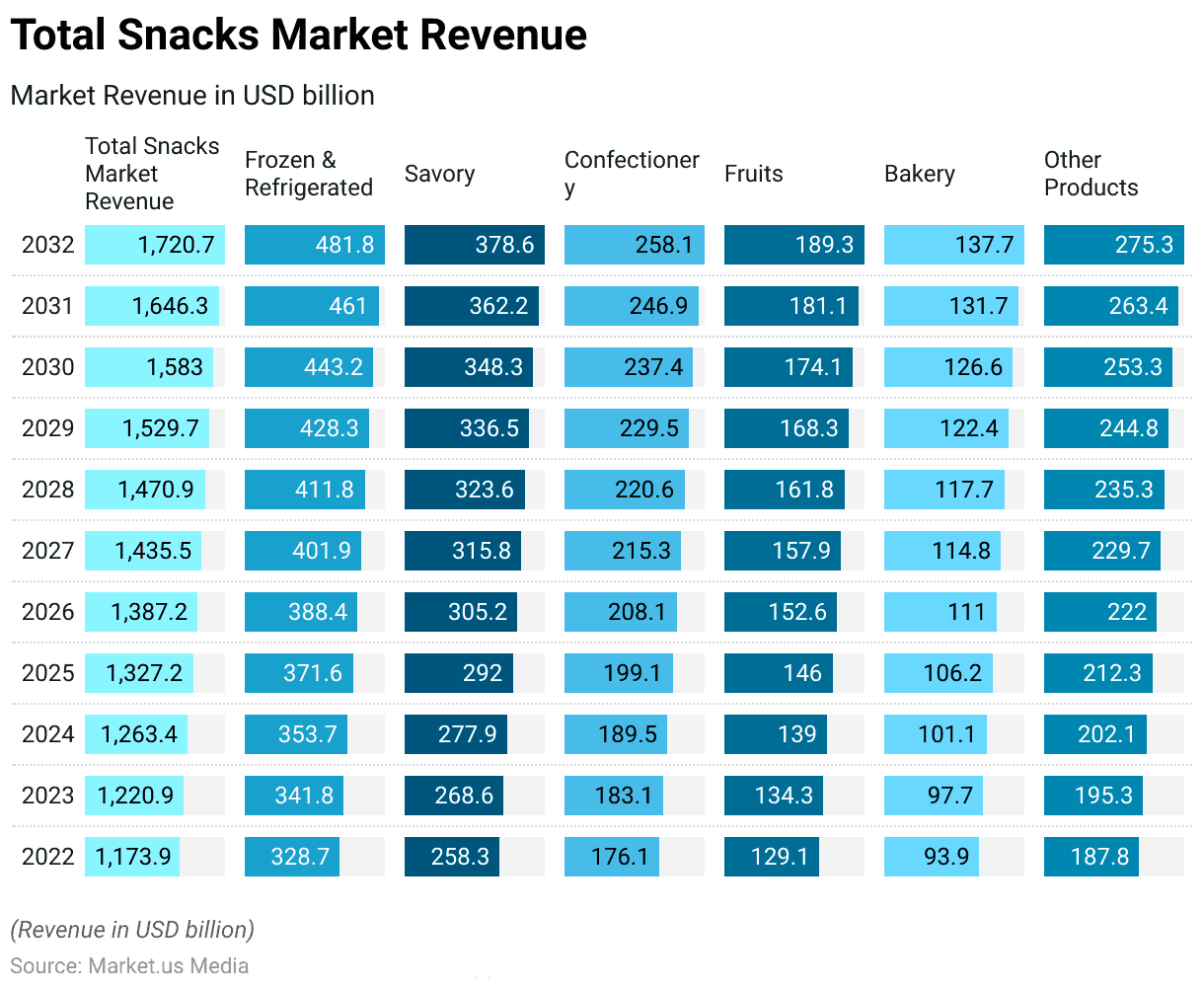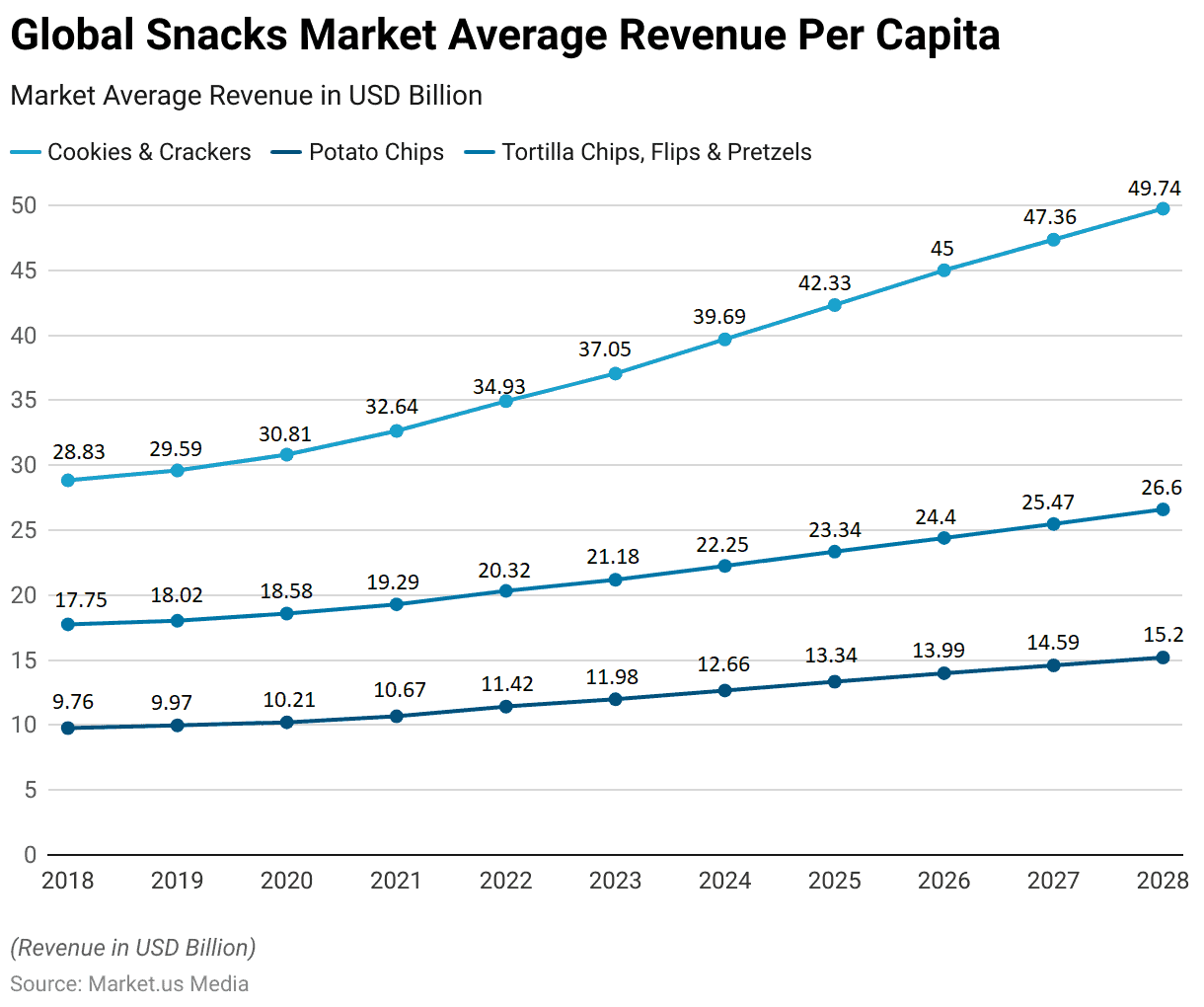Table of Contents
Introduction
According to Snacks Statistics, The snacks industry worldwide is thriving and continuously expanding, offering a diverse selection of convenient and enjoyable food choices.
Its growth is driven by changing lifestyles and evolving consumer preferences, with snack options like chips, pretzels, popcorn, and nuts becoming increasingly favored.
These snack products are available to consumers through various channels, including conventional retail outlets and online platforms.
Consumer decisions regarding snacks are increasingly influenced by health considerations and a growing emphasis on sustainability. Within this sector, challenges and possibilities exist simultaneously, and competition spurs innovation and adaptation to meet evolving consumer needs.
Editor’s Choice
- In 2023, the global snacks market revenue stood at USD 1,220.9 billion.
- Projections for 2032 anticipate the total snacks market revenue to reach USD 1,720.7 billion, with frozen & refrigerated snacks at USD 481.8 billion, savory snacks at USD 378.6 billion, confectionery snacks at USD 258.1 billion, fruit snacks at USD 189.3 billion, bakery snacks at USD 137.7 billion, and other products at USD 275.3 billion.
- Supermarkets & hypermarkets hold the largest market share, commanding a substantial 43% of the distribution channel, emphasizing their significant role in making snacks accessible to consumers worldwide.
- Notably, by 2022, the average revenue per capita had risen to $34.93 for cookies and crackers, $11.42 for potato chips, and $20.32 for tortilla chips, flips, and pretzels.
- The United States is the top revenue generator, with an impressive revenue of $114 billion.
- On average, women tend to consume approximately 3.1 snack items daily, whereas men typically consume around 2.7.
- Globally, consumers prioritize snacks that contain no additives or preservatives (40%), lack artificial ingredients (34%), or feature natural ingredients with a clean label (33%) as their top choices for healthier snacks.

Global Snacks Market Overview
Snacks Market Size
- The global snacks market has displayed a consistent upward trajectory in revenue over the past decade at a CAGR of 4.0%.
- In 2022, the market’s revenue stood at USD 1,173.9 billion, marking the starting point of this growth trend.
- Subsequently, in 2023, it experienced a notable increase to reach USD 1,220.9 billion.
- As we progress into the early 2030s, the global market is forecasted to continue its expansion, with projected revenues of USD 1,646.3 billion in 2031 and USD 1,720.7 billion in 2032.

Global Snacks Market Size – By Product
- In 2022, the total market revenue amounted to USD 1,173.9 billion, with distinct segments including frozen & refrigerated snacks generating USD 328.7 billion, savory snacks at USD 258.3 billion, confectionery snacks totaling USD 176.1 billion, fruit snacks with USD 129.1 billion, bakery accounting for USD 93.9 billion, and other products contributing USD 187.8 billion.
- Projections for 2032 anticipate the total snacks market revenue to reach USD 1,720.7 billion, with frozen & refrigerated at USD 481.8 billion, savory at USD 378.6 billion, confectionery snacks at USD 258.1 billion, fruit at USD 189.3 billion, bakery snacks at USD 137.7 billion, and other products at USD 275.3 billion.

Snacks Market Share – By Distribution Channel
- Supermarkets & hypermarkets hold the largest market share, commanding a substantial 43% of the distribution channel, emphasizing their significant role in making snacks accessible to consumers worldwide.
- Convenience stores follow closely, accounting for 23% of the market share, reflecting the convenience-seeking behavior of consumers who prefer quick and easy access to snacks.
- The online channel, representing 21% of the market share, has seen notable growth, driven by the increasing trend of e-commerce and the convenience it offers in snack purchases.
- Other distribution channels, comprising 13% of the market share, encompass a variety of retail outlets, emphasizing the presence of niche and specialized avenues for snack distribution.

Global Snacks Market Average Revenue Per Capita
- The global snacks market has exhibited consistent growth in average revenue per capita over the past decade.
- In 2018, the average revenue per capita for cookies and crackers stood at $28.83, while potato chips, tortilla chips, flips, and pretzels recorded figures of $9.76 and $17.75, respectively.
- Notably, by 2022, the average revenue per capita had risen to $34.93 for cookies and crackers, $11.42 for potato chips, and $20.32 for tortilla chips, flips, and pretzels.
- Looking further ahead, by 2028, these figures are expected to reach $49.74, $15.20, and $26.60, reflecting the enduring appeal and market expansion of these snack segments.

Snacks Industry Regional Statistics
Snacks Industry Revenue – By Country
- The global snacks industry has seen substantial revenue contributions from various countries, reflecting the widespread popularity of snack products.
- Leading the pack, the United States stands as the top revenue generator, with an impressive revenue of $114 billion.
- Following closely behind, Japan contributes significantly with $82 billion in snack industry revenue.
- India and China, two emerging markets, also make noteworthy contributions, with $75 billion and $64 billion, respectively.
- Mexico, Russia, and Canada, while relatively smaller in scale, each play their part, contributing $14 billion, $13 billion, and $12 billion to the industry’s overall revenue.

Commonly Consumed Snacks- By Region
United States
- In the United States, a significant portion of snack enthusiasts indulge in various snack categories at least once a week, revealing distinct preferences among consumers.
- Notably, chips or crisps lead the pack, with 53% of snackers enjoying them every week.
- Nuts, seeds, or dried fruits closely follow, with 51% of consumers incorporating these healthy options into their weekly snacking routines.
- Similarly, candy and chocolate bars share the same percentage of 51% in weekly consumption, indicating a sweet tooth among a substantial portion of the population.
- Cookies also hold a notable presence, with 43% of snackers savoring them regularly.

Great Britain
- In Great Britain, the weekly snacking habits of consumers reveal distinct preferences for various snack categories.
- Chips or crisps are particularly popular, with a significant 73% of snackers enjoying them at least once a week.
- Nuts, seeds, or dried fruits also have a strong presence, with 65% of individuals incorporating these wholesome options into their weekly snacking routines.
- Candy and chocolate bars, known for their sweet indulgence, maintain a notable following, with 62% of consumers savoring them regularly.
- Cookies, while slightly less frequent, still find favor with 41% of snackers, showcasing their enduring appeal.

Germany
Take advantage of our unbeatable offer - buy now!

- In Germany, the weekly snacking habits of consumers reflect a diverse range of preferences across different snack categories.
- Notably, chips or crisps hold a prominent place in the snacking landscape, with a substantial 72% of snackers enjoying them at least once a week.
- Nuts, seeds, or dried fruits, while popular, exhibit a slightly lower frequency, with 44% of individuals opting for these nutritious choices regularly.
- Candy and chocolate bars also maintain a significant following, with 43% of consumers indulging in these sweet treats weekly.
- Meanwhile, cookies, though slightly less frequent, still find favor with 39% of snack enthusiasts.

Snacks Consumption According to Demographics
By Age
- In the United States, consumers are increasingly turning to snacks as meal replacements, and this trend varies across different age groups.
- Among individuals aged 18 to 24, a substantial 58% opt for snacks as meal replacements when at home, indicating a strong preference for this convenient and quick dining option.
- The trend continues among those aged 25 to 34, with 52% of this group choosing as a meal replacement.
- Similarly, individuals in the 35-44 age bracket also exhibit a preference for snack-based meals, with 53% embracing this practice.

By Gender
- On average, women tend to consume approximately 3.1 snack items daily, whereas men typically consume around 2.7.
- The primary driving factor for both genders when choosing snacks is taste. However, women are more inclined than men to select based on specific expectations, such as seeking sweetness, crunchiness, or healthiness.
- In general, women appear to find a bit more satisfaction from indulging in sweets and snacks compared to men.
- When it comes to snack preferences in France, chocolate stands out as the snack that brings the most pleasure to people, regardless of their gender.
Healthy Snacks Preferences Statistics
- In the realm of snacking, the concept of “natural” is closely associated with healthiness.
- Globally, consumers prioritize that contain no additives or preservatives (40%), lack artificial ingredients (34%), or feature natural ingredients with a clean label (33%) as their top choices for healthier snacks.
- In the United States, the consumption of protein-fortified snacks has risen across all age groups, with the most significant increase observed among individuals aged 32 to 45.
- When people reach for a snack, indulgence often plays a crucial role in their selection, even when health-conscious. This explains why dairy products like yogurt (69%), dairy milk (63%), and cheese (60%) are among the most popular globally, offering both nutrition and indulgent taste and texture.
Latest Snacking Trends
- According to the 2023 Snacking Survey conducted by Circana, nearly half of consumers, which is 49%, report that they are now enjoying more than three snacks daily.
- This represents a notable increase of four percentage points in snack consumption within the past two years among households.
- These results highlight that consumers are increasingly turning to their favorite snacks as a cost-effective way to address their needs, especially in challenging times, whether it’s for mental health or general well-being.
- A significant majority, which is 78% of consumers, express that they make an effort to enjoy indulgent slowly, while 61% mention that they take the time to portion out their snacks before eating them.
Discuss your needs with our analyst
Please share your requirements with more details so our analyst can check if they can solve your problem(s)



